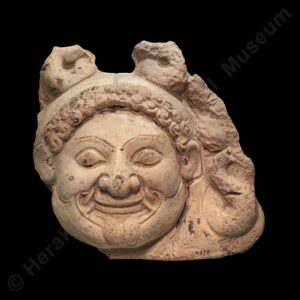
In Greek mythology, Medusa (also called Gorgo) is one of the three Gorgons. In the main variations of the myth, Medusa was a beautiful mortal woman whom Athena transformed into a monster, either because she boasted of being more beautiful than the goddess or because she was raped by Poseidon. She was turned into a winged monster with a human face, and later beheaded by Perseus. Especially in the iconography of the Archaic period she is also seen full-figure, in the conventional “kneeling-running” stance, with knees bent to the right and body and head shown frontally. Most commonly, however, Medusa’s head, the “Gorgoneion” is depicted. It is often seen in the art of the historical era (vase-painting, architectural sculpture, metalwork) as an apotropaic feature, intended to avert evil. The head is depicted frontally, with a round face, large eyes and protruding tongue. Snakes spring from the head, while the forehead is crowned with a row of curls. Found as the central element of Athena’s aegis or a shield emblem. Perseus beheading Medusa was a particularly popular theme in ancient Greek art, chiefly in the Archaic period.